From J. D. Hooker [11 June 1864]1
Kew
Saturday
Glorified friend!
Your photograph2 tells me where Herbert got his Moses for the Fresco in the House of Lords.3—horns & halo & all— Well done William. Your mouth comes out funnily like F. Wedgwoods!4 Do pray send me one for Thwaites,5 who will be enchanted with it. Oliver6 is calling out too for one.
The best news in your letter is, that I may run down with a possibility of seeing you. I shall do so as soon as I possibly can—but am engaged both 2 Sundays, to come.7 I shall be repaid with seeing Mrs Darwin if you are not well enough:—& more than repaid—so you need not mind being ill!!!
I can get our agent8 to look out for a good ship for Scott for Calcutta direct, if he will let me know about time of starting.9
I am delighted to hear of the Oxlip case.— it explains why the oxlip varies so much—now towards C. now towards P.10—as I observed it to do about Hitcham—11 it does not however quite explain to me why in certain large patches it is so uniform as to variety as it certainly is.— Except indeed you suppose that insects may take pollen from C to P. or vice versa only.
I will ask Harvey about the Dandelion—12 I send you another case of his13 which I must also see to. (NB. I do not hold that sports of branches &c do not revert)—
I will write next week about the plants.
No more at present | Yr affec | J D Hooker
[Enclosure]
A curious divarication of the common garden Myosotis (which I suppose to be M. sylvatica) has just appeared under my nose in the following manner. I had, in a border, a large tuft, which I brought last year from the North of Ireland—& just when it was beginning to open out the inflorescence before flowering—I took a trowel & divided the tuft through the middle, taking up one half of it, which I transferred to a pot, & after a few days to the drawing room window—& covering up the other half, again—in the border.
In a few days both came into blossom—the Border plant after its ordinary manner—But, on looking at the potted plant one morning I was surprised to see, as I supposed, that several of the stems were already out of flower (as it looked)—before I had noticed their having been in flower. But, on applying a pocket lense the truth came out—quite differently! to wit—These stems were in full bloom, like the rest—but both calyx & corolla very unlike the normal ones.
|
The Calyx in the ordinary = |
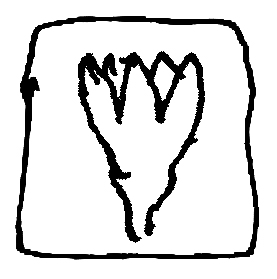
|
The Ditto in the Extraordy = of larger & broader sepals united much higher up, expanded at tips—& the tube broadly obconic. |
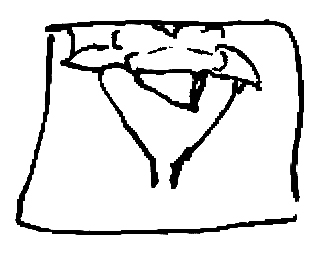
|
But the corolla is most changed—it has a tube shorter than the calyx, perfectly open in the throat, without the 5, toothlike or glandlike prominences of Myosotis, also without hairs under the orifice—& lastly of a pea-green colour—identical with that of the calyx. The genitalia seem perfect & already the carpels are swelling into nuts, which look as if they would be of different form from those of Myosotis. I shall try for seed—by & by, & I hope it may be still in flower when you come.
I recently found (& sent to Darwin) a monstrous Dandelion in which all the fl. heads of the stock, amounting to 8 or 10 were similarly transformed, thus.—14 The flowers were a fulvous-orange, like those of the orange Hieracium—& all the achenes were (see next page) shaped
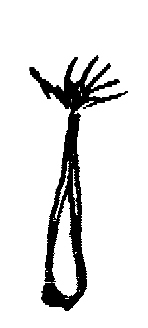 & quite smooth—instead of
& quite smooth—instead of
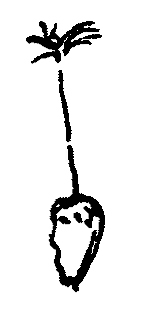 as they out to be.
as they out to be.
I did not examine (being hurried) but if the ovary had an ovule—here was a jump from one Composite genus to another. No writer on Cichoraceæ would, I suppose, put such dissimilar achenes in the same genus.15
Do you not hold that divaricated species never return again to their normal conditions?16— Bain17 has in his garden the old mother plant of the variety “Frizellæ” of Aspl. filix fœmina (you know it = with fronds like Aspl. trichomanes.)
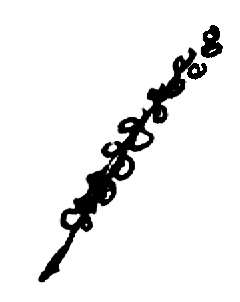
But it has seen the error of its way, & after having propagated thousands of little heretical aberrants, it now comes out in its old dress, as genuine filix fœmina!18
Yours W H Hy
Footnotes
Bibliography
Correspondence: The correspondence of Charles Darwin. Edited by Frederick Burkhardt et al. 29 vols to date. Cambridge: Cambridge University Press. 1985–.
Desmond, Ray. 1994. Dictionary of British and Irish botanists and horticulturists including plant collectors, flower painters and garden designers. New edition, revised with the assistance of Christine Ellwood. London: Taylor & Francis and the Natural History Museum. Bristol, Pa.: Taylor & Francis.
DNB: Dictionary of national biography. Edited by Leslie Stephen and Sidney Lee. 63 vols. and 2 supplements (6 vols.). London: Smith, Elder & Co. 1885–1912. Dictionary of national biography 1912–90. Edited by H. W. C. Davis et al. 9 vols. London: Oxford University Press. 1927–96.
Post Office London directory: Post-Office annual directory. … A list of the principal merchants, traders of eminence, &c. in the cities of London and Westminster, the borough of Southwark, and parts adjacent … general and special information relating to the Post Office. Post Office London directory. London: His Majesty’s Postmaster-General [and others]. 1802–1967.
Variation: The variation of animals and plants under domestication. By Charles Darwin. 2 vols. London: John Murray. 1868.
Summary
CD’s photograph looks like J. R. Herbert’s Moses in the fresco in the House of Lords.
JDH is delighted about oxlip, but hybridity does not explain some large patches that are uniform and do not vary towards either cowslip or primrose.
Encloses letter from W. H. Harvey discussing Myosotis sylvatica and the common dandelion.
Letter details
- Letter no.
- DCP-LETT-4529
- From
- Joseph Dalton Hooker
- To
- Charles Robert Darwin
- Sent from
- Kew
- Source of text
- DAR 101: 225–6; Royal Botanic Gardens, Kew (letters to J. D. Hooker, vol. 11, no. 178 JDH/2/1/11)
- Physical description
- ALS 3pp encl 2pp inc
Please cite as
Darwin Correspondence Project, “Letter no. 4529,” accessed on 19 April 2024, https://www.darwinproject.ac.uk/letter/?docId=letters/DCP-LETT-4529.xml
Also published in The Correspondence of Charles Darwin, vol. 12


